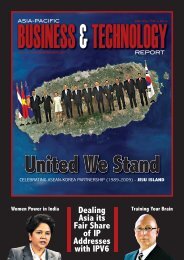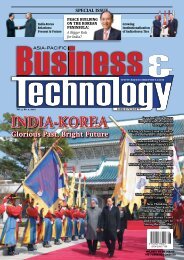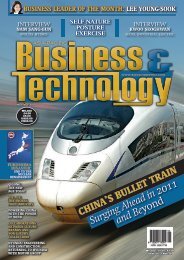GreeN Growth - Asia-Pacific Business and Technology Report
GreeN Growth - Asia-Pacific Business and Technology Report
GreeN Growth - Asia-Pacific Business and Technology Report
- No tags were found...
You also want an ePaper? Increase the reach of your titles
YUMPU automatically turns print PDFs into web optimized ePapers that Google loves.
usinesswww.biztechreport.comImportance of Logistics Industryfor Growing Economiesby Shamila JanakiramanLogistics involves thedelivery of products orservices for the clientwith assured quality <strong>and</strong>quantity.The logistics industry also depends onthe timeliness in which products are deliveredto a destination. Promptness is of utmostimportance, as delayed delivery canresult in significant losses to the recipientof the consignment in most cases. ‘Betterlate than never’ does not work well for thelogistics provider.The logistics industry depended previouslyon transportation more than anything.Nowadays, however, good infrastructure<strong>and</strong> record-keeping have beenimproved by advancements in technology,integration, globalization, legislation, <strong>and</strong>confederations.The immense growth witnessed by theretail <strong>and</strong> manufacturing industries hasbrought warehousing <strong>and</strong> logistics facilitiescloser to towns <strong>and</strong> cities. Previouslysituated in remote areas near waterfronts<strong>and</strong> rail tracks, these facilities are now increasinglybeing located within rural areas<strong>and</strong> city borders.Logistics forms an important part of thesupply chain <strong>and</strong> involves the planning,implementation, <strong>and</strong> effective forward <strong>and</strong>reverse flow of goods, services, <strong>and</strong> relatedinformation from origin to recipient. A logisticiancontrols the smooth functioningat every stage within legal boundaries enablinglogistics management.Logistics management is comprised ofmaterials management, channel management,physical distribution, <strong>and</strong> supplychain management. It also includes thewarehouse management system whichtakes control of stocks, <strong>and</strong> streamlines themovement of goods in the storage units.Logistics Industry TrendsCertain logistics activities can be outsourcedto third-party logistics (3PL) providers,which include transporters whoferry goods from company warehouses toa port or vice versa. Fourth-party logistics(4PL) providers use resources, capabilities,<strong>and</strong> technology to manage the entire logisticsprocess for a customer, unlike a 3PLChristos Georghiou | Dreamstime.comThe immensegrowth witnessedbythe retail <strong>and</strong>manufacturingindustrieshas broughtwarehousing<strong>and</strong> logisticsfacilities closerto towns<strong>and</strong> cities.provider who takes care of only one function.A 4PL provider manages other 3PLs,including truckers, forwarders, <strong>and</strong> customhouse agents comprising the entiresupply chain.The immense growth in the logistics industry,especially in the emerging economiesover the past decade, ensures a brightfuture with 3PLs. Shipping logistics companieshave gained a lot in these regions,with a large contribution coming from3PLs such as transporters, warehouse facilityowners, <strong>and</strong> brokers in freight-relatedjobs.Non-asset-based logistics providers donot include transporters or couriers. Theterm refers to providers who undertakeconsultation services on packaging <strong>and</strong>transportation, freight quoting, financialsettlement, auditing, tracking, customerservice, <strong>and</strong> issue resolution. These expertsdo not own any physical assets, but ratherpossess freight industry knowledge, informationtechnology know-how, <strong>and</strong> associatedassets.On-dem<strong>and</strong> transportation is an evolvingfield within the 3PL industry. The ondem<strong>and</strong>model includes services like fulltruck load (FTL), hotshot (direct, exclusivecourier), next flight out, or commercialairline shipping, <strong>and</strong> international expedited.As this field caters to the specialneeds of clients, it comes at a premiumprice <strong>and</strong> hence is profitable for 3PL providers.<strong>Asia</strong>n Logistics IndustryThe robust trade, economic growth, <strong>and</strong>liberalization policies followed by many<strong>Asia</strong>n countries have resulted in increasedtrade volumes. The ensuing increase intransportation, h<strong>and</strong>ling, <strong>and</strong> warehousingneeds has led to a dem<strong>and</strong> for integratedlogistics solutions in the region.Increased globalization in manufacturing<strong>and</strong> other technological advancements hasmade companies focus more on core activities,<strong>and</strong> thus logistics activities have beenoutsourced as a cost-effective solution.In the case of India, the growing economynow requires a boost in its logisticsservices to keep the goods flowing at anincreasing rate. The logistics field is nowestimated at a value of more than $US14billion, with further growth envisioned.Logistics-related services in India encompasstransportation of goods by air, l<strong>and</strong>,waterway, <strong>and</strong> railway.Air freight ensures rapid, safe, <strong>and</strong> evensame-day delivery of goods <strong>and</strong> is hencemuch preferred. India, which boasts anextensive network of roads, prefers touse them to transport household goods,machinery, <strong>and</strong> vehicles. Another costeffective<strong>and</strong> older mode of logistics is viathe railway transport system, which carriesvehicles, oil, <strong>and</strong> coal from one end ofthe country to the other in huge volumes.Shipment of goods on waterways is especiallyuseful in international shipments ofhuge quantities of goods like grains, oil, orsensitive articles like uranium.The logistics industry in India has grownfast, overriding major sectors like metals<strong>and</strong> mining. Strategically located cities likeMumbai were earmarked for setting up logisticsparks with investments to the tuneof US$200 million. Export processing zoneshousing several companies ranging fromgarment to electronics have necessitatedthe need for a good logistics backbone tosupport the domestic market as well as internationaltrade.The Indian logistics industry is poised togrow annually at the rate of 15-20 percent,reaching a revenue outcome of US$385 billionby 2015. The market share of the organizedsector in logistics will also grow to 12percent by 2015, opine market analysts.Data reveals that nearly 110 logisticsparks covering 3,500 acres, set up at a costof US$1 billion, will become operational by2012. This will include huge warehousingfacilities developed by logistics companiesat an expense of US$500 million.China <strong>and</strong> Taiwan have been cooperatingin efforts to improve logistics techniques.Since the advent of online shoppingin China, the importance of deliveryfirms has grown manyfold. Taiwan’s logisticscenters are assisting Chinese logisticsservice providers nowadays. The hugepotential of China’s logistics scenariocan be proved by the overall turnover inFactoids• Logistics forms an important partof the supply chain <strong>and</strong> involves theplanning, implementation <strong>and</strong> effectiveforward <strong>and</strong> reverse flow ofgoods, services <strong>and</strong> related information.• In order to maintain a competitiveadvantage, logistics companies mustleverage available knowledge moreefficiently to evolve into innovationbasedlogistics service providers.2010, which was estimated at 110 trillionChinese Yuan (US$16.6 trillion). This representsa huge business opportunity forlogistics-related companies. The expectedincrease in China’s GDP will give a furtherboost to this industry.The logistics costs in China are high,yet they can easily be lowered. One hurdleChina faces in this industry is that there isno unified business tax system. Currently,a three percent business tax is levied ontransportation, loading <strong>and</strong> unloading,along with another five percent levy onwarehousing <strong>and</strong> distribution <strong>and</strong> othertaxes.In spite of the growing economy inChina, the logistics industry can be said tobe continuing to suffer, but all city governmentsunderst<strong>and</strong> the importance of logisticscenters for rapid urban development.Taiwanese logistics companies are preferredby Chinese clients over ones fromHong Kong <strong>and</strong> foreign enterprises for upgradingChina’s logistics sector.With the Chinese logistics businessscene as potentially lucrative as it is, severalTaiwanese companies have set up logisticscenters on l<strong>and</strong> provided by Chineselocal governments. A food logistics parkwas established in Chengdu by the Hai-Pa-Wang Taiwanese seafood restaurant, forexample. Another cross-strait commerce<strong>and</strong> trade cooperation zone was set up inKunshan in Suzhou.Logistics operations can also be simple,as in the case of the Philippines, where buslines are used to carry goods in provincialoperations. Although not entirely dedicatedto carrying goods, almost all bus lines acceptpackages for delivery on their routes.The sender has only to deposit the packageat the nearest bus terminal <strong>and</strong> inform therecipient about the consignment.As buses operate between routes continuously,this localized logistics systemserves a huge population <strong>and</strong> may even bethe fastest mode of delivery. Perishableslike vegetables, fruits <strong>and</strong> flowers alsofollow this mode to reach urban marketsfrom villages in all parts of the world, oftenreaching their destination in the weehours of the morning.Continued from Page 31China, 20 percent of which is generated byhydroelectric power.However, analysts believe the main reasonfor the current power shortage is largelythe lower power prices which are being controlledto feed manufacturing units, therebypreventing hydroelectric power generationfrom being optimized. Drought is incidentalto the overall lowered production of hydroelectricpower in China, presently.<strong>Technology</strong> in LogisticsA systems-driven approach using advancedsystems to integrate <strong>and</strong> simplifylarge, complex operations is required tostreamline production activities up todelivery. A fully-integrated supply chainmanagement solution will help systemsintegration <strong>and</strong> management besides enhancingdecision support <strong>and</strong> visibility ofthe company’s worldwide inventory.Information technologies in the logisticsindustry include the application of datacollection technologies <strong>and</strong> the Internet.Data collection <strong>and</strong> exchange are criticalfor logistics information management <strong>and</strong>control, as they can be leveraged to delivercustomers’ goods more accurately <strong>and</strong> efficiently.The bar code system <strong>and</strong> radiofrequency identification system (RFID) aredata collection technologies that are usedwidely for this.Companies rely on information technologyto enable integration, order <strong>and</strong> transportationmanagement <strong>and</strong> warehousemanagement. RFID technology is used totrack vehicles, pallets, <strong>and</strong> even smallerunits to gain greater visibility.Electronic data interchange (EDI), electronicordering system (EOS), logistics informationsystem (LIS), enterprise informationportals (EIP), <strong>and</strong> knowledge management(KM) are information technology elementsused in the logistics industry. Electronicdata interchange involves inter-companycomputer-to-computer exchange of businessdocuments in st<strong>and</strong>ard formats.A good logistics company integrates allthe supply chain functions ranging fromraw material sourcing <strong>and</strong> manufacturingto the distribution of finished goods. Thecompany has to control costs of transportation<strong>and</strong> inventory while working out strategiesto serve customers optimally withinset time periods <strong>and</strong> budgets.All this makes supply chain managementcomplex, <strong>and</strong> therefore companiesneed real-time visibility to gain optimal insightsinto the flow of goods from suppliers<strong>and</strong> even suppliers’ suppliers. Better visibilityreduces wait times, <strong>and</strong> helps manageinventory <strong>and</strong> costs. Different companiesneed different solutions designed accordingto the product, volumes involved, location,<strong>and</strong> so on.Global supply chain management canbe enhanced by systems integration <strong>and</strong>management to provide a tight vigil onworldwide inventory <strong>and</strong> transportationexpenditure. Supply chain management,lean logistics which emphasizes waste reduction,inventory control, st<strong>and</strong>ardizedwork, <strong>and</strong> mistake-proofing are other requisitesof a good logistics provider. In orderto maintain competitive advantage, logisticscompanies must leverage availableknowledge more efficiently to evolve intoinnovation-based logistics service providers,say experts. A-PThe Road Map AheadChina has a very limited pathway aheadof it. It has to improvise <strong>and</strong> implementgreener practices of production as the presentheavy pressures on the limited water resourcesavailable for both irrigation <strong>and</strong> industrialproduction is creating a widespreadnegative impact. Alternative resources forindustries have to be found, since there aresuch a large number of industries involved.Economic growth at the cost of environmentdegradation is a non-progressiveroute. Sustained development will providea positive impact <strong>and</strong> better all-around resultsfor China. A-P34 | A-P BUSINESS & TECHNOLOGY REPORT A-P BUSINESS & TECHNOLOGY REPORT | 35









